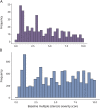Long-term disability progression of pediatric-onset multiple sclerosis
- PMID: 31092624
- PMCID: PMC6598792
- DOI: 10.1212/WNL.0000000000007647
Long-term disability progression of pediatric-onset multiple sclerosis
Abstract
Objective: To evaluate long-term disability progression in pediatric-onset multiple sclerosis (POMS) and compare to adult-onset multiple sclerosis (AOMS).
Methods: This was a retrospective cohort study using prospectively collected clinical information from the Swedish MS Registry. Clinical features were compared and Kaplan-Meier and Cox proportional hazards regression were used to assess the risk of reaching sustained Expanded Disability Status Scale (EDSS) 3, 4, and 6 in POMS (multiple sclerosis [MS] onset <18 years) and AOMS (MS onset ≥18 years).
Results: A total of 12,482 persons were included; 549 (4.4%) were classified as POMS. The POMS cohort took longer to reach all 3 disability milestones from their MS onset, but did so at a younger age than the AOMS cohort. Primary progressive course (hazard ratio [HR] 4.63; 95% confidence interval [CI] 1.46-14.7), higher relapse rate in the first 5 years of disease (HR 5.35; 95% CI 3.37-8.49), and complete remission from the initial relapse (HR 0.41; 95% CI 0.18-0.94) were associated with an altered risk of progression to EDSS 4 among POMS cases. The same pattern emerged for the risk of reaching EDSS 3 and 6.
Conclusions: Patients with pediatric-onset MS follow a distinctive clinical course, which should be considered in the treatment and management of the disease.
Copyright © 2019 The Author(s). Published by Wolters Kluwer Health, Inc. on behalf of the American Academy of Neurology.
Figures




References
-
- Tortorella P, Rocca MA, Mezzapesa DM, et al. . MRI quantification of gray and white matter damage in patients with early-onset multiple sclerosis. J Neurol 2006;253:903–907. - PubMed
Publication types
MeSH terms
LinkOut - more resources
Full Text Sources
Other Literature Sources
